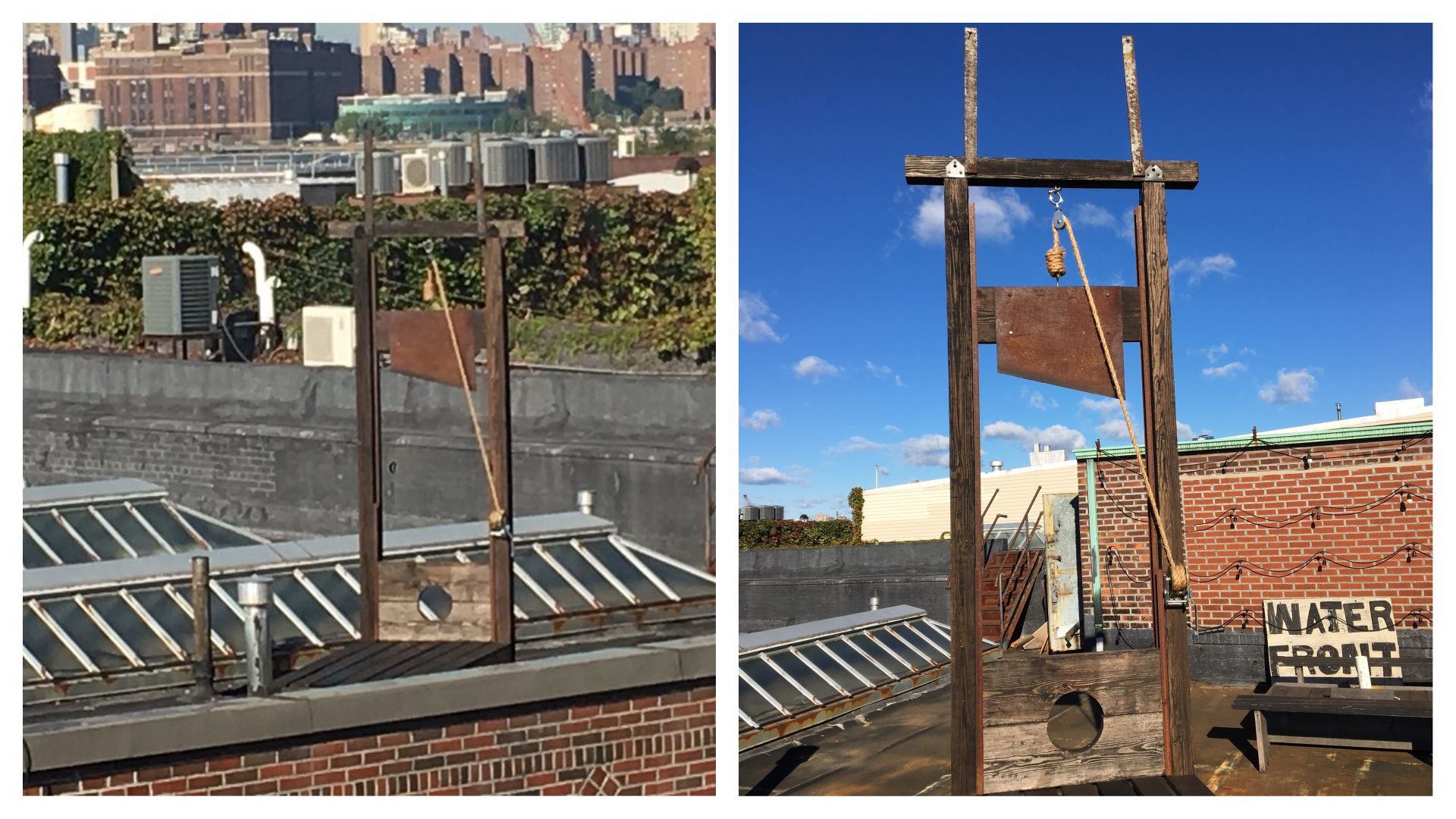The Story Behind the Mysterious Guillotine on a Brooklyn Roof

Hannah Silk Champagne was getting ready to have a tricky conversation with her boss on Monday when she saw it: a massive, rusty guillotine on the roof across from her office in Greenpoint, Brooklyn.
“It just appeared there. It’s literally across from my desk,” she told me.
After Champagne tweeted a photo of it two days later, the image went viral, drawing curiosity from near and far. CBC radio contacted her, as did other journalists, myself among them. At least one Reddit thread was spawned, on the WTF subreddit. The guillotine was creepy, which is appropriate given the Halloween season, but it also seemed unavoidably political—a totem of the French Revolution emerging at a time when pseudo-revolutionary sentiment is rising on the left. Was this a message to the ruling class? An active-use device being employed to decapitate elites? A prank? Whatever it was, people seemed drawn to it—Champagne’s original tweet has 25,000 likes and counting.
In fact, it was a symbol of a broken, for-profit healthcare system that long predates Donald Trump, according to James Schieberl, the photographer and artist who built the thing. I stumbled upon the San Diego native while poking around the intersection at which the guillotine had been spotted. The door to the building was propped open, to my surprise, and Schieberl—groggy but very friendly—was just arriving at his studio when I ambushed him.
“I always thought it was ridiculous that, out of however many first-world countries, that we were the only ones who don’t have free healthcare,” the 36-year-old explained as he gave me an up-close look at the device Thursday. “So, yeah, this is kind of the idea behind that—just like, here’s your free healthcare. It’ll solve your problems.” (The name of the piece, which was displayed at an art show around the 100-day marker of Trump’s administration last year but conceived years before, is, in fact, Free Healthcare.)
That was his angle, he insisted—not to spark a new revolution, but to draw attention to the most pernicious and deadly aspect of modern capitalism.
“Just kinda how fucked up our healthcare system is,” Schieberl, who said he is a registered Independent and vaguely left of center, told me. “Just how stupid it is that we don’t have universal healthcare. How privatized it is. They’d much rather see you dead than healthy, I guess. They want to make money off you.”
OK, next question: Does it, you know, work? Schieberl told me that he did his share of research on the specifications and constructed it as authentically as possible. “I don’t know if it can kill but it can definitely maim,” he said, adding later via email that he’d used it on beer cans and a watermelon. He went on to note that he built it “a little extra wide, for today’s American, just to be accommodating.”
From what I can tell, the guillotine has never seen official use in America. But Noah Feldman, a Harvard legal historian, explained that it was an object of local fascination dating back to the aftermath of the American Revolution. Thomas Jefferson recalled a contemporary allusion to George Washington and a Supreme Court justice being butchered by the French Terror device coming up at a cabinet meeting—to the rage of Washington. Robespierre was also cited as an example by David Bradford, the leader of the short-lived Whiskey Rebellion, though he could not have known, the historian recalled, that the Terror had turned on its leader—and Robespierre had already been guillotined days earlier. (Feldman also pointed me toward an obscure mid 90s Georgia bill to establish death by guillotine as evidence that the concept had staying power in the American imagination.)
“In a fall of Rome kind of place like New York City, the hint or suggestion or natural implication for most viewers would be that plutocrats are not long for the world and that the Revolution is coming,” Feldman told me.
When I asked why it was displayed on his building’s rooftop, and whether that was intended to send a message, Schieberl told me it was mostly there just because he’d recently opened a studio in the building and displayed works for the occasion and left it up after the fact. Besides, it was fine if it took a beating—he’d deliberately let it grow rusty as part of the construction process, “just to get it weathered—make it more gnarly.”
And if it does send a message?
“I do like that,” he told me. “Maybe people will trip out on it. And it’s Halloween.”
Sign up for our newsletter to get the best of VICE delivered to your inbox daily.
Follow Matt Taylor on Twitter.
This article originally appeared on VICE US.